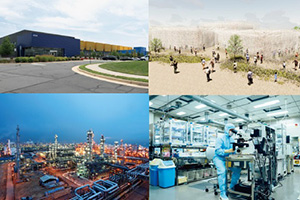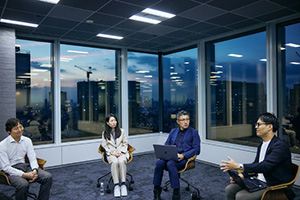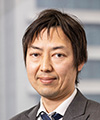 |
|||||||||
|
|
|||||||||
|
NTT IOWN Technology Report Vol. 23, No. 2, pp. 14–18, Feb. 2025. https://doi.org/10.53829/ntr202502sw1 Release of NTT IOWN Technology Report 2024AbstractNTT Research and Development Planning Department released the NTT IOWN Technology Report 2024, which summarizes its vision for the Innovative Optical and Wireless Network (IOWN), the concept of which was unveiled in 2019, and technologies intended to make the world a better place for everyone. This article provides an overview of this report. Keywords: technology, future vision, IOWN 1. Text structure of NTT IOWN Technology Report 2024Since unveiling the concept of the Innovative Optical and Wireless Network (IOWN) in 2019, we have diligently advanced research and development (R&D) efforts to make it a reality. In NTT IOWN Technology Report 2024, we introduce the status and future vision of the IOWN project. We highlight four ongoing IOWN projects that can significantly contribute to the industrial sector: overseas datacenters, data-centric infrastructure (DCI) implementation at the Expo 2025 Osaka, Kansai, Japan Pavilion, remote factory maintenance and inspection, and photonics-electronics convergence devices. We introduce the key innovation points of each project with a sense of realism, based on interviews with local stakeholders. We also envision how urban development will change through IOWN and what services and solutions will be created in the near future as IOWN technology advances and becomes more widespread, based on discussions with experts. Finally, we introduce the latest trends in the IOWN Global Forum (IOWN GF), which continues to expand in scale year by year and create various use cases. 2. Overview: The potential and progress of the IOWN visionJapan faces a range of pressing societal challenges, particularly environmental concerns. The exponential growth in data volume has driven a sharp increase in electricity consumption. Energy demand is poised to increase significantly, particularly in urban areas. Generative artificial intelligence (AI), which is now being rolled out in a range of business settings, requires large amounts of energy, requiring us to address both energy and environmental concerns without halting technological innovation. Equally pressing is Japan’s worsening labor shortage. As the working population continues to shrink, industries such as construction and transportation are in dire need of solutions for lessening the impact of what is often referred to as the ‘2024 problem,’ a labor shortage resulting from the enforcement of overtime work regulations in these industries. Compounding these challenges is the country’s aging population. IOWN, the next-generation communication infrastructure unveiled by NTT in 2019, is positioned to help address these challenges. IOWN aims to deliver a communication network with 100 times greater energy efficiency*1, 125 times more transmission capacity*2, and 200 times lower latency than current systems by transitioning components of network and computing infrastructure from electronic (electricity-based) to photonic (light-based) technology*3. By using photonics for both data transmission and processing, and constructing a networking architecture that integrates such technologies, NTT envisions that IOWN will revolutionize networking and computing, opening new avenues of value creation in the future. We have pursued R&D in various fields to make this vision a reality. IOWN spans many domains of networks, computing, platforms, and services, from the network and computing revolution of the All-Photonics Network (APN) and Cognitive Foundation, photonics-electronics convergence devices that push the transition from electricity to light in devices, to the 4D Digital PlatformTM, which is built atop these technologies and can process vast amounts of data in real time to enable future prediction and data convergence across multiple industrial platforms. In early 2023, NTT launched IOWN 1.0, which includes ultra-low latency network services via the APN and compact, energy-efficient devices for networks. Looking ahead, NTT plans to introduce photonic technology for logic board-level (board-to-board) connections as part of IOWN 2.0 by 2025, package-to-package connections as part of IOWN 3.0 by 2028, and intra-chip (die-to-die) connections as part of IOWN 4.0 by 2032. As these advancements unfold, photonics-electronics convergence devices will be integrated into networks and servers, pushing communication infrastructure to new levels of functionality. The expansion of IOWN cannot be separated from the rapid development of AI. The rise of generative AI and new models has been transformative across industries, and NTT is developing its own large language model (LLM), tsuzumiTM, drawing on more than 40 years of natural-language-processing research. IOWN plays a pivotal role in advancing LLMs like tsuzumiTM. NTT is conducting experiments that integrate IOWN’s APN and LLM technologies. By directly linking each central processing unit (CPU) and graphics processing unit (GPU) through photonic switching, NTT aims to optimize resource usage for LLM training and inference, developing next-generation LLMs that maximize GPU efficiency while minimizing resource use.
3. Reportage: The impact of IOWN in accelerating businessWorldwide, proofs of concept (PoCs) are underway to build out IOWN. From transforming infrastructure through innovations centered on the APN, revolutionizing spatial experiences with cutting-edge communication technologies, to enabling real-time, long-distance connectivity in manufacturing, IOWN is reshaping industries. These advancements are being driven by innovations in semiconductor packaging, and as IOWN expands across countries, sectors, and domains, it will fundamentally transform business operations. We visited four key sites where these transformations are taking place (Fig. 1).
3.1 IOWN and public infrastructure: Building the backbone of society in 2030 (overseas datacenters)Datacenters form the backbone of the Internet infrastructure that powers our daily lives. One of the most crucial hubs in this network is NTT’s large-scale datacenter in Ashburn, USA—sometimes referred to as ‘Data Center Alley.’ A PoC using the APN is currently underway. In a recent PoC, the APN linking datacenters located four kilometers apart has drastically cut latency to 0.062 milliseconds and jitter to an impressive 0.045 microseconds. By connecting datacenters in distant locations with ultra-low latency, this PoC is poised to enhance the flexibility and resilience of this infrastructure. We visited the Ashburn site to observe the innovations being implemented in datacenter infrastructure. 3.2 IOWN and urban space: Dynamically evolving architecture that integrates emotions (DCI implementation at the Expo 2025 Osaka, Kansai, Japan Pavilion)The Expo 2025 Osaka, Kansai, Japan, planned to be held on Yumeshima Island in Osaka, will serve as a testing ground for cutting-edge technologies. NTT aims to create ‘NATURAL’ architecture that softly embraces visitors—a departure from the rigid structures of traditional pavilions. This project represents the world’s first deployment of DCI. We visited both the NTT Pavilion construction site in Osaka and Musashino R&D Center in Tokyo to explore how this real-time, adaptive space will be brought to life and to understand the concept of ‘NATURAL architecture.’ 3.3 IOWN and construction and manufacturing: The flexibility and connectivity of next-generation factories (remote factory maintenance and inspection)IOWN’s network innovations are poised to revolutionize manufacturing. As part of a use-case study by the IOWN Global Forum, a PoC is currently underway at a Mitsubishi Chemical Group facility. The PoC centers on remote factory maintenance and inspections conducted from hundreds of kilometers away. Robots and drones equipped with advanced sensors and cameras detect anomalies in real time, with the help of a digital twin. We covered the PoC site of NTT COMWARE and NTT DATA, where they are conducting tests on remote robot operation while connecting the Tokyo districts of Gotanda, Otemachi, and Odaiba via the APN. This PoC offers a preview of the future manufacturing landscape. 3.4 IOWN and energy: Pioneering energy innovation through photonics-electronics convergence (photonics-electronics convergence devices)The IOWN revolution extends beyond networking to encompass computing, driven by advancements in photonics-electronics convergence devices. These crucial devices are making strides from R&D to large-scale production. Advances from silicon photonics to membrane photonics are driving the miniaturization of these devices, which are poised to significantly impact the global semiconductor industry. At the forefront of this transformation are NTT’s Atsugi R&D Center and Shinko Electric Industries Co., Ltd. We visited these two sites to interview researchers and engineers about their aspirations for mass-producing photonics-electronics convergence devices, which are significantly smaller and more energy-efficient than traditional semiconductor packages, combined with high-precision manufacturing techniques. 4. Roundtable: Unveiling IOWN’s role in shaping next-generation smart citiesIn the post-COVID-19 world, changing lifestyles and pressing challenges, such as aging populations and the need for effective disaster response, are reshaping expectations for smart cities. How will IOWN reshape our evolving expectations of smart cities? To explore this, Seiichi Saito, Panoramatiks Principal who has extensive experience in integrating technology into urban development, joined a discussion with NTT Group members (NTT, NTT Communications, NTT DOCOMO) to share insights into the possibilities of the future (Fig. 2). The discussion began with an introduction to specific examples of using IOWN in urban development, followed by a debate on how communication infrastructure shapes city planning and redefines regional value in the future. The presence of IOWN, which is friendly to both people and the planet, provides spaces that facilitate essential human ‘activities’ for urban development. Opinions were also exchanged on the potential future where the relationships between cities evolve.
5. Perspective: Expanding the IOWN networkAs detailed in this report, IOWN is making strides across multiple sectors as its implementation advances. Partnerships and collaborations with others outside of NTT are pivotal to driving these initiatives forward. The IOWN network is rapidly transcending corporate silos, national borders, and industrial sectors. One of the most notable examples of this breadth is IOWN GF, founded in January 2020 by Intel Corporation, Sony Corporation (now Sony Group Corporation), and NTT. This international organization has brought together companies from a broad spectrum of industries to work towards achieving the IOWN vision. With members ranging from manufacturers and telecom operators to information technology vendors, major platforms such as Google, and even advertising firms, the forum brings together a rich mixture of diverse technologies and expertise. A hallmark of IOWN GF’s activities is its focus on real-world use case studies that illustrate the ‘smart world’ envisioned by IOWN. Several projects, such as the PoC at the chemical plant mentioned earlier in this report, were born out of these collaborative efforts. The DCI implementation at Expo 2025 has also benefited from collaboration, particularly in sourcing specialized hardware. These initiatives exemplify the IOWN GF’s broad industry participation and the active engagement of its member companies in discussions to materialize IOWN and accelerate its deployment. NTT has forged global strategic partnerships, notably with the opening of the world’s first international IOWN APN with Chunghwa Telecom in Taiwan. This connection, linking Chunghwa Telecom’s datacenter with NTT’s Musashino R&D Center, has achieved stable unwavering low-latency communication with a one-way duration of approximately 17 milliseconds across a distance of 3000 kilometers. This collaboration is set to accelerate global IOWN business development using international APN connections, particularly in business continuity precautions. 6. AfterwordBeyond the examples highlighted in this report, the technology will be applied to new efforts across sectors such as telemedicine, entertainment, and beyond. These efforts are also intricately linked to broader societal issues. NTT, with its long-standing commitment to exploring the potential of ‘natural technology,’ remains focused on how technology can evolve to benefit both people and the planet. IOWN envisions not merely a new communications infrastructure but a new kind of technology that can support both people and the environment. NTT Research and Development Planning Department will continue to release summaries of technology trends and the activities of NTT R&D. NTT IOWN Technology Report 2024 can be downloaded from NTT R&D’s website [1]. Reference
|
|||||||||













